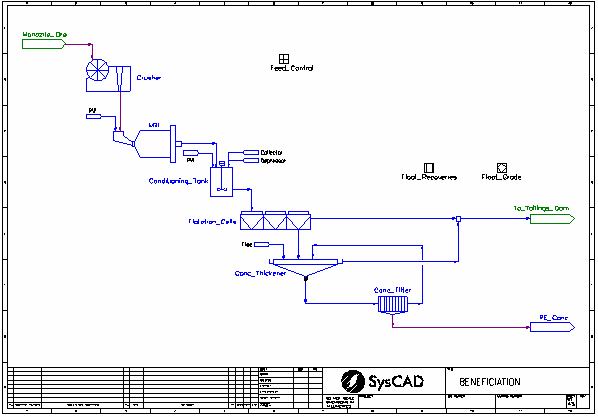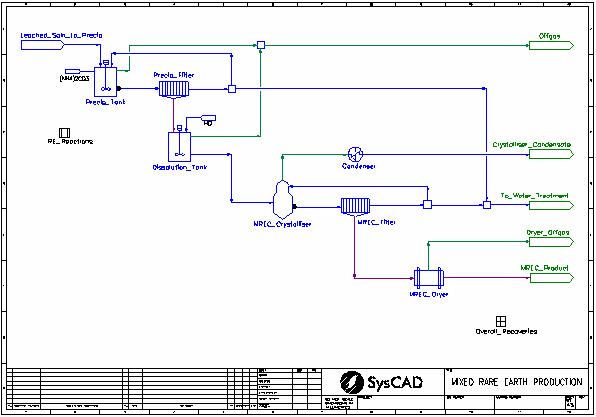Rare Earths Project
Jump to navigation
Jump to search
Navigation: User Guide ➔ Example Projects ➔ 60 Rare Earths
Rare Earths Example Project
Rare Earths Example Project |
Project Location
This is a Steady State project and is stored at:
..\SysCADXXX\Examples\60 Rare Earths\Demo Rare Earths Project.spf
Available from Build 139.29706.
Features Demonstrated
- The use of the Flotation Cell model.
- The use of the General Separator model.
- The use of the Filter Press model.
- The use of the Evaporator model.
- The use of the Simple Condenser model.
- The use of Makeup Sources and Makeup Blocks.
- The use of Reaction Blocks, including the use of Source, Heat Exchange, Override Product Temperature Option and Final Fraction extent type.
- The use of a PID Controller.
- The use of Set Tag Controllers.
- The use of General Controllers.
- The use of Model Procedures.
- The use of Species Calculations.
- The use of the Evap sub-model.
- The use of the EHX sub-model.
- The use of Split Flows Gas Vent option.
Brief Description
- This is a simplified model of a typical Rare Earths plant to produce a Mixed Rare Earth product from a Monazite ore. The project is loosely based on the following papers:
- "Extractive metallurgy of rare earths" by F Habashi (2013), Canadian Metallurgical Quarterly, 52:3, 224-233 (https://www.tandfonline.com/doi/full/10.1179/1879139513Y.0000000081)
- "A critical review on solvent extraction of rare earths from aqueous solutions", by F Xie, T.A. Zhang, D. Dreisinger and F. Doyle (2014), Minerals Engineering 56, 10-28, especially figures 1 and 11.
Beneficiation
- Monazite ore with 2% Total Equivalent Rare Earth Oxide (TREO) and 2% moisture is sent through a crusher.
- Process water is added to the crusher product to produce a slurry @ 70% solids which is sent to a mill.
- The mill product is sent to a conditioning tank where flotation reagents (collector and depressor) are added and the slurry is further diluted with process water to 30% solids.
- The slurry is sent to flotation cells where 80% of the Rare Earth phosphates are recovered to the concentrate stream.
- The flotation concentrate is sent to the Concentrate Thickener to increase the solids concentration from 30% to 50%. Floc is added to the thickener.
- Overflow from the thickener and flotation tailings are combined and sent to a Tailings Dam.
- The underflow from the Concentrate Thickener is sent to the Concentrate Filter to produce a cake with 5% moisture. The cake is sent to Chemical Treatment while the filtrate is returned to the thickener.
Chemical Treatment
- The RE concentrate from Beneficiation is sent to a Roaster where the Rare Earth phosphates are reacted with added sulfuric acid to produce aqueous sulfates at 200 °C. Most of the water present in the feed is evaporated.
- The roasted concentrate is sent to a Leach Tank where it is cooled to 40 °C by the addition of water.
- The leached concentrate is sent to the Leach Thickener to increase the solids concentration to 40%. Floc is added to the thickener.
- The underflow from the Leach Thickener is sent to the Leach Residue Filter to produce a cake with 5% moisture. The leach residue cake is discarded while the filtrate is returned to the thickener.
- Overflow from the thickener is sent to the Neutralisation Tank.
- In the Neutralisation Tank, MgO is added to neutralise most of the sulfuric and phosphoric acids present in the feed.
- The neutralised slurry is sent to the Leached Solution Filter to produce a cake with 2% moisture. The neutralisation residue cake is discarded while the filtrate is ready for further processing.
- The neutralised filtrate is split between a Mixed Rare Earth process and single rare earth separation processes (not modelled).
Mixed Rare Earth Production
- The leached solution is sent to a Precipitation Tank where Ammonium Carbonate is added to force the precipitation of the rare earth elements as carbonates.
- The resulting slurry is sent to the Precipitation Filter to produce a cake with 5% moisture. A portion of the filtrate is recycled back to the Precipitation Tank, while the rest is sent to the Water Treatment Plant (not modelled).
- The cake from the Precipitation Filter is sent to the Dissolution Tank where the addition of hydrochloric acid causes the rare earth carbonates to dissolve as aqueous chlorides at 80 °C.
- The resulting solution is sent to the MREC Crystalliser where the rare earth chlorides precipitate. The crystalliser operates at a pressure of 5 kPa. Vapours from the crystalliser are sent to a condenser.
- The resulting slurry is sent to the MREC Filter to produce a cake with 2% moisture. A portion of the filtrate is recycled back to the MREC Crystalliser, while the rest is sent to the Water Treatment Plant (not modelled).
- The cake from the MREC Filter is dried in the MREC Dryer at 90 °C to a moisture content of 0.1%.
- The final MREC product contains mainly rare earth chlorides with Total Equivalent Rare Earth Oxide (TREO) of approximately 66%.
- The overall recovery from feed ore to Mixed Rare Earth product is approximately 30%, with a further 30% recovered to a leach solution ready for single rare earth separation processes.
Project Configuration
- Most units with reactions are simulated by the Tank or Tie model. This includes the Roaster, Leach Tank, Neutralisation Tank, Precipitation Tank, Dissolution Tank and MREC Dryer.
- A Reaction source is used in the MREC Dryer to add the required amount of oxygen gas (O2).
- The Heat Exchange (RHX) function is used in the Roaster and Leach Tank to control the discharge temperature.
- The Override Product Temperature Option is used in the Precipitation Tank, Dissolution Tank and MREC Dryer. This option is chosen to set the discharge temperature as thermodynamic data is not available for all species participating in reactions.
- The Final Fraction extent type is used in the MREC Dryer to control the final moisture content.
- The Flotation Cells are modelled by a single Flotation Cell model.
- Both Thickeners are modelled by the General Separator model using the Solid Separation SplitMethod with OF Solids Fraction and UF Solids Fraction sub methods. The Leach Thickener has the EHX sub-model enabled to control the discharge temperature.
- All Filters are modelled using the Filter Press model.
- The MREC Crystalliser is modelled using the Evaporator model. It allows user defined reactions, uses the VLE submodel and automatically splits the gases and slurry to separate outlets.
- The Condenser is modelled using the Simple Condenser model.
- Separation of gases and slurry is usually achieved by the use of Split Flows Gas Vent option.
- Process Water is added via Makeup Blocks:
- in the Mill to achieve a target percent solids.
- in the Conditioning Tank to achieve a target percent solids.
- in the Leach Tank to achieve a target water fraction.
- Various reagents are added via Makeup Blocks:
- Collector and Depressor are added to the Conditioning Tank based on a Mass Ratio to solids in the feed.
- Floc is added to the Concentrate and Leach Thickeners based on a Mass Ratio to solids in the feed.
- Sulfuric Acid (H2SO4) is added to the Roaster based on a Mass Ratio of H2SO4 to solids in the feed.
- A fixed mass flow of Magnesium Oxide (MgO) is added to the Neutralisation Tank.
- A fixed molar flow of Ammonium Carbonate ((NH4)2CO3) is added to the Precipitation Tank.
- A fixed molar flow of Hydrochloric Acid (HCl) is added to the Dissolution Tank.
- The Roaster uses the Evap sub-model to evaporate 98% of the water present at a constant temperature.
- A PID Controller is used to control the TREO grade in the flotation concentrate by adjustment of the CePO4 grade.
- Set Tag Controllers are used to:
- set the recovery to concentrate of all rare earth phosphates to the same value in the Flotation Cells.
- set the reaction extents for conversion of rare earth phosphates to sulfates to the same value in the Roaster.
- set the reaction (precipitation) extents for conversion of rare earth sulfates to carbonates to the same value in the Precipitation Tank.
- set the reaction (dissolution) extents for conversion of rare earth carbonates to chlorides to the same value in the Dissolution Tank.
- set the reaction (precipitation) extents for rare earth chlorides to the same value in the MREC Crystalliser.
- set the reaction (precipitation) extents for conversion of rare earth sulfates to oxides to the same value in the MREC Dryer.
- set the reaction (precipitation) extents for rare earth chlorides to the same value in the MREC Dryer.
- A General Controller is used to set the Monazite Ore composition as Rare Earth phosphates based on rare earth oxide equivalents and Total Equivalent Rare Earth Oxide (TREO).
- A General Controller is used to calculate the TREO recoveries in each process area.
- Model Procedures are used in three tanks:
- Neutralisation Tank: calculates required MgO based on reaction extents and excess requirement and then sets MgO makeup.
- Precipitation Tank: calculates required (NH4)2CO3 based on reaction extents and excess requirement and then sets (NH4)2CO3 makeup.
- Dissolution Tank: calculates required HCl based on reaction extents and excess requirement and then sets HCl makeup.
- Species Calculations are defined in the Rare Earths Example configuration (cfg) file and used in the project to show:
- Equivalent rare earth oxides (and some other elements) in both solid and liquid phases.
- Heavy Equivalent Rare Earth Oxide (HREO), Light Equivalent Rare Earth Oxide (LREO) and Total Equivalent Rare Earth Oxide (TREO) in both solid and liquid phases as well as combined totals.
- PO4 in both solid and liquid phases.
- SO4 in liquid phase.
Included Excel Report
Rare Earths Example Report.xlsx
This file has the following reports:
- Criteria
- Streams
- Mass Balance


